Por favor, use este identificador para citar o enlazar este ítem:
https://hdl.handle.net/11000/1915Registro completo de metadatos
| Campo DC | Valor | Lengua/Idioma |
|---|---|---|
| dc.contributor.author | San Blas, Angel A. | - |
| dc.contributor.author | Vidal, A . | - |
| dc.contributor.author | Quesada Pereira, F. D. | - |
| dc.contributor.author | Pérez Soler, J. | - |
| dc.contributor.author | Gil, J. | - |
| dc.contributor.author | Vicente, C. | - |
| dc.contributor.author | Gimeno, Benito | - |
| dc.contributor.author | Boria, Vicente E. | - |
| dc.contributor.other | Departamentos de la UMH::Ingeniería de Comunicaciones | es |
| dc.date.accessioned | 2015-10-01T13:33:57Z | - |
| dc.date.available | 2015-10-01T13:33:57Z | - |
| dc.date.created | 2015-04-29 | - |
| dc.date.issued | 2015-10-01 | - |
| dc.identifier.uri | http://hdl.handle.net/11000/1915 | - |
| dc.description.abstract | A novel technique for the full-wave analysis of 5 3D complex waveguide devices is presented. This new formulation, based on the Boundary Integral- Resonant Mode Expansion (BI-RME) method, allows the rigorous full-wave electromagnetic characterization of 3D arbitrarily-shaped metallic structures making use of extremely low CPU resources (both time and memory). The unknown electric current density on the surface of the metallic elements is11 represented by means of Rao-Wilton-Glisson basis functions, and an algebraic procedure based on a singular value decomposition is applied to transform such functions into the classical solenoidal and non-solenoidal basis functions needed by the original BI-RME technique. The developed tool also provides an accurate computation of the electromagnetic fields at an arbitrary observation point of the considered device, so it can be used for predicting high-power breakdown phenomena. In order to validate the accuracy and efficiency of this novel approach, several new designs of band-pass waveguides filters are presented. The obtained results (S-parameters and electromagnetic fields) are successfully compared both to experimental data, and to numerical simulations provided by a commercial software based on the finite-element technique. The results obtained show that the new technique is specially suitable for the efficient full-wave analysis of complex waveguide devices considering an integrated coaxial excitation, where the coaxial probes may be in contact with the metallic insets of the component. | en |
| dc.description.sponsorship | This work was funded by the Spanish MINECO (Grant TEC2013-47037-C5-4-R) | - |
| dc.format | application/pdf | es |
| dc.format.extent | 38 | es |
| dc.language.iso | eng | es |
| dc.rights | info:eu-repo/semantics/openAccess | es |
| dc.subject | ondas electromagnéticas | es |
| dc.subject | microondas | es |
| dc.subject.other | CDU: 621 - Ingeniería mecánica en general. Tecnología nuclear. Electrotecnia. Maquinaria::621.3 - Ingeniería eléctrica. Electrotecnia. Telecomunicaciones | es |
| dc.subject.other | CDU: 537 - Electricidad. Magnetismo. Electromagnetismo | es |
| dc.title | Highly efficient full-wave electromagnetic analysis of 3D arbitrarily-shaped waveguide microwave devices using an integral equation technique | en |
| dc.type | info:eu-repo/semantics/article | es |
| dc.identifier.doi | 10.1002/2015RS005685 | - |
| dc.relation.publisherversion | http://dx.doi.org/10.1002/2015RS005685 | - |

Ver/Abrir:
San_Blas_Radio_Science.pdf
495,68 kB
Adobe PDF
Compartir:
 La licencia se describe como: Atribución-NonComercial-NoDerivada 4.0 Internacional.
La licencia se describe como: Atribución-NonComercial-NoDerivada 4.0 Internacional.
.png)